As you may know, I have recently come into possession of a Microsoft Surface RT. The device is what I would call “very interesting” and I look forward to playing with it for the next few days, and then jumping into NaNoWriMo with it.
I bought it with the idea in mind that like many phones on the market these days, it may never receive software updates and may never have more software or functionality than what it did the day it was opened from its box. Generally, unless the device you’re buying is a standard PC with an x86 processor, this is good advice to follow. Even older general purpose computing platforms may never have gotten much or good third party software, or replacement operating systems when their vendor folded or the platform was outmoded by that vendor’s next big thing.
My personal head-canon involves two competing theories about how the Windows RT platform will shake down. The first of these theories is that I’ve just spent a fair chunk of change on a curious piece of history that’ll eventually be viewed as a PC-companion rather than as an independent computing platform, or that its limited software availability puts it next to Windows NT on the Alpha computers as, again, an interesting side note in history, even if the machines were fast and the hardware itself had a future with other operating systems.
The other theory is that Windows RT will be huge, and it has a future that involves dethroning one or more competing computing platform, not only for light-weight Excel boxes, but as a way for home users to get a hardier and more durable version of Windows, or as a way for home users to get an inexpensive machine for their first computer. In this way, RT grows significantly as a “starter” platform and as devices that extend a network, get used for travel computers, and get given to children.
Whichever way it shakes down, I’ll be there watching, and using the device(s) that come out for the platform, just as I’ve been watching and using iOS.
Buying a Surface
Every experience with a completely new computing platform (or even partly completely new) starts with the experience of buying into that platform. The Surface has been hyped up over the course of several months, and “we” have known for quite a long time that the primary way to buy one would be to go to the Microsoft store and pick one up or order one from Microsoft’s Online Store. The day the preorder went live, I very nearly placed my order online, but I had been vaguely planning the trip to Scottsdale to go buy it for a long time, and I had been hearing online that Microsoft was really working on preparing its staff to assist customers make the decision as to which new Windows computer they should buy.
And so I conned one of my co-workers into taking the adventure on Saturday the 27th, hoping that the store would still have a few in the back room the day after release.
In Scottsdale, after locating the Microsoft shop (fairly close to the Tesla Motors retail location, just around the corner from the Louis Vuitton shop, I absolutely kid you not), what I found was a store full of friendly employees wearing blue “Windows 8” shirts and name-badges on lanyards. In the center of the store was about half a dozen tables full of Windows 8 launch PCs, mainly Microsoft’s own Surface RT, along with the Sony Vaio T, the Asus Vivo Tab (and/or the Samsung Ativ Tab, I don’t know if there’s any difference between those devices) and a few desktops (and more Surfaces) lining the edges of the store, showing off what Windows is like on some more traditional form factors and showing various solutions Microsoft has set up for people who are coming into a retail store looking at computers.
Immediately I was greeted by a friendly 20-something who later revealed that he had been working with computers for five whole years, and knew a good product when he saw one. He was quick to instruct me that I should have a seat at the Surface and play around a little bit before I purchased one. My initial take-away was that the device was fast and that the Touch Cover keyboard was better than I thought it would be. He was helpful and very interested in what I’d be using it for, probably so that he could steer me toward a more traditional piece of Windows hardware in case I mentioned any key words like financial software or existing app. I mentioned that I’d been following the development of the device on blogs, and that I was excited to finally try the OS out on a new piece of hardware.
The employee and I chatted a few more minutes about what the Surface was like and he even suggested that I might be writing an app for it, and wondered what apps I was excited to try were. I felt like my answers to these questions were probably pretty lame, but it was as honest as I was going to get – I told him I intend to use it as my primary mobile computer, and I told him that I had poked a little bit around with Windows Development before, and might make it a point to have an app in the store one day.
After chatting a little bit more, and poking around the demo surface, I went ahead and purchased the 32 gigabyte model paired with the Touch Cover. I like accessories so I also grabbed a power adapter and a VGA adapter, which were a healthy $40 each. The purchasing process was relatively painless, although Microsoft’s point of sale kiosks are a little bit hilarious. I bet they’re using Dynamics on the back end, and the signature pad is definitely a custom Tablet PC housed inside this hoky little enclosure. My hope is that they get that cleaned up a little bit as time moves on. Later on in the day, I grabbed a 16GB Micro SDHC card to fill out the MicroSDXC slot in the device.
In another set of attempts to be as much like Apple as possible, the employee helped me take the Surface out of the box and get signed into it, and also put the rest of my goodies (including the now bare box the Surface came in) into a large, colorful Microsoft bag, featuring the company’s new logotype and the primary Windows logo colors.
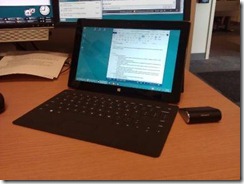
Hardware
I like the Surface, a lot. It’s a well-built piece of hardware, the stand is quite clever, and the Touch Cover is a nice addition, in a market where your tablet’s keyboard is either Bluetooth, or attached in such a way that turns the tablet into a clamshell laptop. It’s weird, but it’s definitely nice.
The specs on the Surface are fairly respectable too – it has a 1.3GHz quad core nVidia Tegra processor, 2 gigabytes of memory, a 1366x768 display (IPS!) and the model I bought has 32 gigabytes of storage. When I first pulled it out of the box, it had about sixteen gigabytes of space available, which is respectable. Price-wise, it compares very well to the 16GB “new iPad” – you get about sixteen gigs of space on either, and within any given tablet lineup, available space for user content seems to be the biggest differentiator.
I also love the fact that it’s slightly expandable. The single USB port is a signal: “Come, hook whatever you may up to this device!” and while Microsoft has been conservative in telling you what to do with it, the fact that it’s there is a great sign. (Also, as it happens, Microsoft has built drivers for a lot of todays’ most popular devices. Printers are said to work, and Microsoft has made references to scanners working as well.) The inclusion of a MicroSD slot is also quite nice, and I’ve already installed a 16GB card, just in case.
While I can’t say enough good things about the “Surface” part of the hardware, I just can’t quite get the hang of the Touch Cover, and when I’m actually using the device, I’m either going to be doing touch-centric things, consuming content rather than creating it, or using a USB keyboard such as the old IBM/Lenovo USB UltraNav keyboard, which is what I’m currently doing. This is another weird thing about the Surface for me, the point, at least for me, of getting a Surface is that you can use it to do all sorts of new things, but some elements of the device (like that USB port) implicitly suggest that you do old-style things with it, such as hook up a USB keyboard and mouse, a large external hard drive, or even a printer.
The device also has a pair of cameras, which produce decent enough pictures. I don’t think they’re as good as the pictures the iPad 3 makes, but I am on the “why are you judging a tablet by its photographic capabilities?” boat. These cameras will work great for quick snaps when you already have the Surface out, self-portraits, recording the results of a science experiment in OneNote/OneNote MX notebooks, or even as the primary camera for somebody buying a Surface RT as their very first computer, who may not have a camera at all.

The other obvious thing I need to talk about is the kickstand. Holy crap the kickstand. It’s gorgeous. The sounds it makes are fantastic – quiet, but fantastic – and the sheer utility of having a tablet that stands up on its own is fantastic. I understand that Apple wants to make as few suggestions as possible about how a customer should use their device, which is why they sell the iPad almost completely unadorned, and let accessory vendors and customers decide what to attach to it, but the kickstand is so unobtrusive that nobody who didn’t want it would know it was there.
The Surface also has decent sounding stereo speakers. When I take it into the living room to use it at the dining table, or when I’m using it at work, I will almost certainly never feel the need to plug additional speakers into it.
Aside from the touch cover, which I have all but given up on at this point, the other odd thing about the Surface is that there’s random crap on both of the short ends. This makes the tablet hard to use in portrait orientation, which is how I would normally use my iPad or the Samsung Galaxy Tab if I were in Kindle catching up on a book, or in a news/magazine application on either of those devices. It’s not impossible to hold, but it is slightly awkward – less because it’s difficult to hold (it’s not, really) and more because of the odd distribution of cameras, ports, and buttons. It’s hard to predict exactly what you’ll be hitting when you hold it.
On more than one occasion, I accidentally exited the app I was using with my thumb, adjusted the volume with a table, or turned the display off with the heel of my hand. Add to that that it’s almost impossible not to wipe a thumb or finger against one of the cameras while holding it, and you’ve got a device that you’re pretty clear is begging to be set on a table. This is the polar opposite of the iPads and many Android tablets, which don’t just ask but beg to be held in your hands. Even the particularly bad 7-inch Samsung Galaxy Tabs have obvious holding positions, both portrait and landscape, and are fairly inviting to hold.
This might be something that some of the other Windows RT OEMs have done better, I didn’t honestly give any of the other Windows 8 devices in the store so much as the time of day, and I’d known from the start if there was a single RT device I had to have, it was going to be the Surface. If I get the opportunity to shop around for one to have at the office, I might go with one of Dell or HP’s devices, or I may look around at what’s happening in the Windows 8 x86 Tablets universe, but the Surface was absolutely it for my home RT device.

One of the things I’ve definitely done after the first day or so with the Surface is to equip it with a better keyboard and mouse for when I’m doing “productivity” stuff on the desktop. I tried very hard from Saturday to Tuesday trying to seriously like the Touch Cover’s keyboard, but couldn’t. What I ended up doing was purchasing a Bluetooth keyboard and mouse from a local retail outlet. In particular, I purchased the Microsoft Wedge Touch Mouse and the Wedge keyboard. They’re adorable, but they’re not the only available options. I like them because they are tiny enough to fit in most of the bags I’ve got without much impact, and wireless devices is a) modern and b) leaves the USB port available for other things, such as headsets, cameras, modems, or whatever.
The other unexpected benefit of the Wedge Keyboard is that it includes a clever cover which can also successfully hold the Surface sideways, for epic portrait-orientation writing. (Not great for print layouts, but great for showing as many words as possible, or just holding the surface up while reading.)
Windows RT
Hundreds of thousands, maybe even millions of words have been written (Typed? Penned? Whatever.) about the hardware of the Surface RT. It’s beautiful hardware and from the moment it was announced earlier in the year, nobody was worried about that at all. The real story here is Windows RT. The good news is that it’s here, and we can all get our grubby paws on it.
The new user interface is not very surprising for those of us who have been using it on x86 computers for a while.
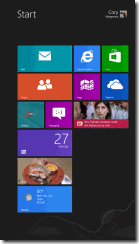
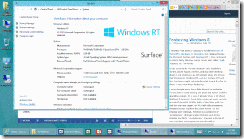
The new desktop is what’s really interesting to me. Although if I didn’t have the System Properties open here, we might never know that the full Windows desktop experience was coming through loud and clear on an ARM processor, in a pure slate tablet device.
“Windows” here is surprisingly complete. It’s got Ye Olde MSTSC for remote desktop connections, you can map drives, you can format USB devices as fat or NTFS, you can create a recovery device for Windows RT, you can even open the registry, cmd.exe or Windows PowerShell. The performance and completeness of this environment is, at first glance, somewhat surprising, even though it probably shouldn’t be. It’s both awkward and charming to open up the My Computer window on an iPad competitor and see that the OS is installed on the C:\ drive.The inclusion of the full desktop versions of Word, Excel, PowerPoint and OneNote is kind of amazing (for me), and is one of this device’s biggest selling points. Microsoft suggests that Office Home & Student 2013 RT is licensed such that if your workplace is licensed for the full version of Office 2010 or 2013, you can use this for work purposes. (In at least one other context they’ve said you can upgrade to a version licensed for commercial use separately, but I have yet to see references to this. I wonder if Microsoft is still at least implicitly suggesting that a regular Windows 8 computer is the best route for “business” use then.)
This is a pretty good deal for a copy of Word, especially given that there was a time when that program alone was a few hundred dollars, and now it’s a few hundred dollars and includes a whole PC with a camera and wireless networking built in.
One of the points it sounds like Microsoft is trying to stress, and I agree with them here, is that the Surface with Windows RT is supposed to be a PC and a post-PC device at once. I am generally inclined to believe that it succeeds here, but it’s worth noting that as of this writing I have only managed to spend five whole days with it before posting this – two or three of those days I didn’t pay attention to it because I was sick.
Did I mention how weird this is? I understand that the NT kernel has been on different hardware before, and Office even came with it (to Alpha, for example) – but in that time during the ‘90s, Alpha was this big hulking supercomputer platform that had made it down to the desktop workstation level, and part of why NT was able to succeed there was Microsoft and DecPaq had collaborated on a binary translation environment that (purportedly) meant that most x86 apps which hadn’t yet been ported ran about as fast as they would have on a midrange intel-based system at the time. This isn’t a desktop supercomputer, though. This is an iPad competitor, in price, in form factor, and in specifications. It’s interesting, then that Microsoft has not been shy at all about allowing users of the device to get to the desktop, and let them do really specific and fiddly things, such as with the Registry and PowerShell.
I like it, but it’s totally the opposite of Apple’s strategy, and it’s even fairly different from the Google strategy with either ChromeOS or Android. I don’t know if it’s just that Microsoft is afraid of letting these components of their hard-built OS go, or if there’s some long-term strategic reason that they’re in here. It very well could be that Microsoft has a long term plan to bring more of its traditional software to the desktop (Access! Oh dear $DIETY, PLEASE let Access be on their list of software to bring to this device!) or if it’s part of a transition period where Microsoft plans to make Surface RT all about the “new User Interface” but just hasn’t yet brought enough software forward to that new environment. To that end, it’s very interesting to me that the device has both OneNote MX (available from the store) and desktop-experience OneNote 2013 on it.
The Post-PC Era
I hopped on the “Post-PC” boat really quickly when the first iPad came out, and I haven’t been shy about airing my opinion that some people need to get with the program and understand that while it may not yet be for everybody, and not every single task will be completed in a “post-PC” environment – Post-PC computing is the wave of the future and in due time, everybody will have forgotten about the bad old days of manually managing their files and manually provisioning storage. Microsoft takes “Post-PC” and slaps us right in the face with it, using Windows 8 and Windows RT. In Microsoft’s eyes, you can have it both, and it’ll be really interesting to see how it shakes down.
One example of “having it both ways” is that the default way to view pictures on the device is with a New Interface application called Photos. However, all of the photos that this application uses are either on your SkyDrive, or stored locally in the folder C:\Users\$USERNAME\My Pictures\ -- screenshots and images from the camera roll are in further subdirectories therein.
One of the things I’ve always been worried about when using my iPad is how I would get my data out if the device were to die horribly somehow, or what the recommended way to back up information is. This has improved a little bit since the introduction of iCloud and Mac OS X 10.8, which centralizes a lot of the most common data onto Apple’s servers, but it still relies on having a Mac and having Pages.app as a desktop application. On the Surface RT, however, I’ve set up Windows 8’s built-in backup application, “File History” to automatically back up everything in that C:\Users\Cory\ folder to a network share on Maithwaite, one of my file server VMs on TECT. I understand not everybody will have a file server hanging around, but Windows RT will also let you select the MicroSDXC slot for backups, and of course you can connect a good old external hard disk to the USB port.
Eventually, I suspect that there’ll be even an option to back up the whole device to SkyDrive, or at least a more comprehensive local sync option with SkyDrive.
This is as good a place as any to air my biggest complaint about Windows RT: It has no local sync option with SkyDrive, whatsoever. This gets back to the original problem I had with my original iPad back in 2010. I’d start writing something on the tablet and have few good ways to get it back to my home computer. This isn’t to say it’s impossible, of course, and since most files on the RT are fairly standard file types like docx/xlsx/png/jpeg et al, copying them to a network share, SDXC card, or uploading them to a web site with the desktop version of Internet Explorer 10 is pretty easy. Even e-mailing documents created on the Surface is slightly better than on the iPad, because you are very much using the same software on Windows RT that you are on a desktop machine with Windows 7 or 8.
The big question I have about Microsoft and the “Post-PC Revolution” is whether or not including the desktop at all changes RT’s viability as an OS for said revolution. When I talk about the iPad with most people, I either don’t talk about resource management at all, because I’m talking with “normal people” who aren’t computing professionals, or I am talking about how the iPad represents an awesome version of the future where individual users don’t need to worry about resource management, because the OS does it for them.
It remains to be seen where RT falls on this spectrum, between Windows 7 (or even more extremely: Windows XP) and iOS, in terms of doing things like automatically killing background applications or applications you haven’t touched for a while. Windows RT has the task manager, the question is whether or not average users will need to visit it on a regular basis.
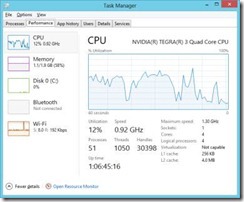
Up to this point, I’ve been fairly conscious about going through and killing New Interface apps as I get done with them. One of the things I should probably do in the next few days is open several New Interface apps and see how the system handles this situation. Fortunately this is fairly easy to check with Task Manager, and I am pretty certain I have seen my x86 Windows 8 PC (despite having 4 gigs of ram) kill off New Interface applications that weren’t being used.
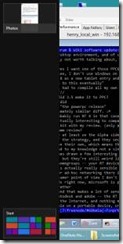
RT’s post-PC apps in the New Interface work fairly well. Microsoft has a few good looking games, there are a few good kid-friendly apps like Wet Paint. I would be happier if SketchBook had made it over from x86 to RT, and I haven’t yet tried any of the New Interface twitter apps, but with the exception of a New Interface text editor that supports syncing with DropBox (like PlainText on the iPad) the core group of communication and entertainment apps I use on my iPad is present and accounted for. Things like Netflix and Hulu are also available, although I haven’t installed them yet. That’ll probably come a bit later on when I get bored of doing my desktop computing on the Surface and in an RDP connection in conjunction, or when I test out dual displays on the Surface.
This is one of those things where evaluating a whole platform on a long-term basis based on what’s available for it on launch day is a bad plan, because we just don’t know what the Marketplace will look like, and how long it’ll take to move from the “lively but still not very interesting” place that it is today, to current state of the iOS app store, where there’s something interesting and well-crafted at every turn. We may ultimately find out that the Windows RT app store will never fill out the way iOS’ has.
Lines in the Sand
Microsoft sells both Windows 8 and Windows RT as though they’re no-compromise computing solutions. There’s a good side to this, and a bad side. For starters, I absolutely love that because I am at home and at my desk, I can use a desktop environment with the full Microsoft Word, Excel, PowerPoint, OneNote and Internet Explorer, in addition to the variety of applications available in the new interface.
However, one of the other desktop applications I’m in approximately 100% of the time, PuTTY, is (as of this writing) never going to be available on the desktop of my Surface RT, because the five main desktop apps (and other secondary/tertiary apps like Notepad, Paint, and MSTSC) are the only apps that’ll ever make it to the Windows RT desktop. This is enforced both by policy, and with the technology.
My current work-around is that I’ve got an 800x600 RDP session open to henry, my Windows 7 desktop virtual machine on TECT. This means that I get to open PuTTY (and other apps) as a full-screen app on a VM on TECT. This is a bit of a bummer though, because it means that I absolutely must have TECT (or another power-consuming x86 PC) running in order to really have the full gamut of applications I need and want available at any given time. This is definitely an issue for me because I would rather each of my devices has full functionality wherever possible.

The other odd line in the sand I’ve noticed is that the Surface RT cannot be the leader of a Windows HomeGroup. This is a minor detail, and I’m not even sure how many real people are using HomeGroup, but it is one more thing that separates the Surface RT from a “real” PC with an x86 processor. It also looks like the ability to set up shares is unavailable.
The question here, I think, is whether or not this stuff is going to change in the future. I think that not being the leader of a HomeGroup and not running file shares makes sense for the Surface RT, but it’ll be very interesting to see whether or not we see the desktop apps (and subsequently, the entire desktop “mode”) go away as Microsoft brings more of the Office suite into the New Interface. I’m also interested in the opposite: Will Microsoft ultimately bring more Office (and other) programs to the Windows RT desktop, and maybe even open it up to third parties? It’s not hard to imagine a fairly vibrant Windows RT desktop ecosystem, especially when third party applications and utilities (and things like custom line of business apps) can be ported to the RT desktop. Especially if we ever see stationary devices running Windows RT.
 One of my important questions is if Microsoft didn’t intend for the desktop to have some kind of future, why go to the effort of porting classic desktop-focused stuff like the command line and PowerShell? It remains a mystery to me, for sure.
One of my important questions is if Microsoft didn’t intend for the desktop to have some kind of future, why go to the effort of porting classic desktop-focused stuff like the command line and PowerShell? It remains a mystery to me, for sure.

The device even has the Device Manager, which is “great” because I love disabling the trackpad on my older (trackpad-equipped) ThinkPad USB UltraNav keyboard.
Building an Ecosystem
One of the other biggest things I’ve heard about Windows 8 and Windows RT is that RT will certainly suffer at the hands of its ecosystem. I question that particular “wisdom” because Microsoft has one of the better cloud and application ecosystems that I’ve used. Particularly, I really like how they’ve brought SkyDrive to the (x86) desktop as an application that syncs some local folders with the cloud, and then back down to your other PCs. In the past year, I’ve started to use SkyDrive heavily for many of my core computing activities, and it’s generally where blog posts go when I’m done pre-writing them, it is where my collections of non-photographic imagery tend to live (at least before they find their final home on the maithwaite file server) and it’s where I put many of my projects and other temporary files I’m working with.
So it was really exciting for me when Windows Phone 7 came out with Office on it, and you could access and save to the SkyDrive. It’s everything we were promised in WinMo6.5, but denied for one reason or another. I’m also a big fan of the Zune (now “Xbox Music”) service and even though I don’t have my main identity on it, I like the Hotmail/Windows Live/Outlook.com e-mail and communication/information management services.
Windows RT integrates with all of this at least as well as Windows Phone 7 does: Which is to say, it’s almost there, when you consider what a tablet with no cellular networking, or a primary PC should be capable of. There’s a SkyDrive application in The New Interface, and the Office 2013 RT applications can directly access SkyDrive, in very much the same way that Office 2007 and 2010 were able to, but there seems to be no option to synchronize all or part of the SkyDrive, and what I’ve had to use the app for so far is pulling files off and putting them into the local file system of the device for later consumption and work. I see this is a low hanging fruit, however, and I suspect that the option will mke
I’m not going to say this is going to be a deal-breaker, but I would be that much happier with the device (and likely to buy the next version, or the 64 GB version) if desktop-level SkyDrive syncing were present, especially given that there’s desktop apps of a variety of types.
In terms of traditional tablet infrastructure, I think that Windows RT is doing fairly well so far. It may not be quite what the iPad had on day 0, and Microsoft isn’t allowing us to install scaled-up phone applications, so it doesn’t even have that advantage from Android, but I am very pleased to report that I saw the Windows Marketplace light up significantly when I first opened it on mine. It’s far from complete, but there’s a good Twitter application, there are several creative utilities (including TrimWord), and a few really good games (like Microsoft’s own Adera) have shown up.
That’s one advantage Microsoft has over Apple. They’ve got a whole game studio under their belt, and a lot of experience (with the xbox and the 360, and a few phone platforms) making pretty compelling games. Adera is a great re-imagination of a point-and-click adventure (or as the case may be, a point-and-tap adventure) and it reminds me of what the creators of The Scarab of Ra for the Macintosh were probably visualizing as they created and played the game.
Office
I have no doubt at all that a lot of people will buy the Surface RT specifically because they fancy themselves Word, Excel, PowerPoint or OneNote power users. Heck, that’s one of my reasons behind owning it.
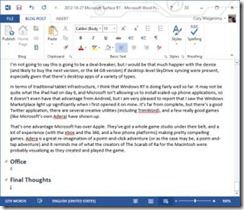
It’s glorious.
In terms of the stuff 90% or so of people will need to do with the four most prolific Office applications, everything’s here. I’ve written this entire review using the Surface, and I could easily open up any of my graphs in Excel, or if I was still a student, I would definitely be using OneNote and PowerPoint side-by side.
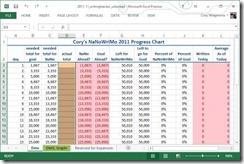
We track words, here in this Excel spreadsheet.
For 90% of everything, It truly is identical to its desktop counterpart. This is one of those situations where I think Microsoft is going to have a challenge when it comes to weaning users off of the desktop versions of these applications, and into New Interface versions. Maybe it really is their intent to continue having all of these options hang around on a long term basis. I do wish that for all of Microsoft’s openness during the development process (from showing it running on developer boards in cardboard cases, to a post fairly candidly talking about the process of selecting OEM partners) they’d tell us a little bit more about the future planning for this platform.
Even though I guess that 90% of the people who Office spend 80-90% of their time in Word, Excel, PowerPoint, and OneNote, this is only about half of the Office suite, and notably missing are Access, Publisher, and some option to at least view Visio files. Having the option to install Visio and Project would go a long way with some people. I happen to be in the “Please Bring us Access!” camp, myself.
It’s possible to use the office apps in conjunction with the touch keyboard, it’s honestly even a little bit clever. The interface buttons in Office’13 get a bit larger and you can choose between windowed keyboards and a full-width keyboard in various layouts. Below, I’ve got a screenshot of the “full” keyboard layout (which I find slightly easier to use, should I need to use the touch keyboard) in full-width mode.
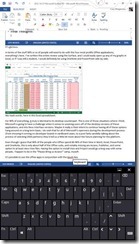
I also like some of the changes in Office 2013, including collapsing sections based on heading styles, and Excel has finally escaped early 1990s MDI hell. Seriously, what the hell, Microsoft? Every single version of Excel on Windows, ever right up to 2010, could only open one Excel document at a time. If you wanted to see the contents of more than one workbook at a time, you either had to own and use more than one computer, do acrobatics in order to open two fully separated copies of Excel, or maximize the Excel window, and manually arrange the Excel document windows within the larger Excel application windows.
Needless to say, it was an absolute mess, and Office 2013 (both on RT and x86) fixes this significantly. Anybody who does any amount of working in more than one workbook should pretty seriously consider upgrading to Windows 7 or 8 and at least Excel 2013.

Final Thoughts
The future of the platform really is the critical point, I think. For the platform to have any future at all, Microsoft has to continue dumping money into it, both in telling consumers the story of Windows RT and convincing them that there’s a good reason to buy it (entire PC ecosystem in a slate tablet that fits in a handbag or messenger bag is pretty compelling, for example) and in bringing more software to the platform. I believe there’s a lot of opportunity that may end up as missed opportunity if Microsoft doesn’t make the Exchange functionality better, as an example, and I suspect there are a lot of people who would pay for something like Streets and Trips or MapPoint 2013, which feature offline map data. In conjunction with a GPS receiver, the Surface RT could be a navigator’s best friend.
Ultimately, I believe that for the platform to succeed, Microsoft has to lead the way. Office needs to come to the “New Interface” or we need to see a little bit more flexibility (maybe even third party flexibility) on the RT desktop, and Microsoft needs to convince third party developers that this is a platform that’s worth their time. This is going to be a hard balance for Microsoft to make, because the platform is already somewhat restrictive, and if Microsoft introduces too many games and applications, third party developers won’t see the ecosystem as one where their third party app (which may do the same thing as something available on the OS natively) can’t be competitive. If I had to say I had a specific hope for something that comes to the platform or changes in the future, it would be the limitations on Windows RT’s desktop. I understand that Microsoft may not want every single desktop Windows utility to make it onto RT, especially because it’s really easy to create a total waste of computing resources with desktop applications on Windows, but it would be nice to see a little bit more flexibility in that space. It would be great not to have to remote into an x86 Windows computer to use an SSH client. (Even a New Interface SSH client would be fantastic.)
Regardless of what happens to the platform, even if Microsoft stops shipping new updates tomorrow, discontinues the product and burns the remaining stock and dumps them in a landfill in Utah, I’ll keep using mine, because for now it provides (for me) an excellent mix of local and remote computing – even if my linux shell is now two hops away, one to an x86 machine with Putty and another out to the slice.
The verdict? It’s great, but it’s clearly a brand new platform and like any brand new platform, suffers in the software selection department. Not even every single app on the Windows Marketplace works, and not even all of the Microsoft apps work on RT. It’s my very sincere hope that Microsoft amends its stance on third party development for the desktop, but I don’t think that’s necessary for the success of the platform.